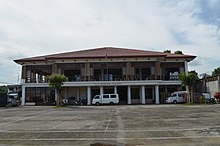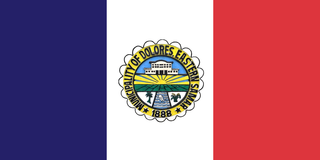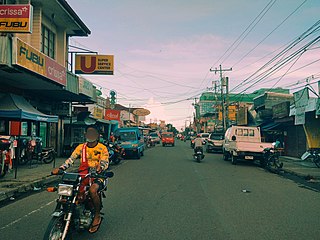This article needs additional citations for verification .(June 2013) |
Palo | |
|---|---|
| Municipality of Palo | |
 | |
 Map of Leyte with Palo highlighted | |
Location within the Philippines | |
| Coordinates: 11°09′30″N124°59′30″E / 11.1583°N 124.9917°E | |
| Country | Philippines |
| Region | Eastern Visayas |
| Province | Leyte |
| District | 1st district |
| Founded | 1596 (as a Jesuit mission) 1768 (as a town) |
| Barangays | 33 (see Barangays) |
| Government | |
| • Type | Sangguniang Bayan |
| • Mayor | Remedios L. Petilla (NPC) |
| • Vice Mayor | Jonathan Chiquillo (LP) |
| • Representative | Ferdinand Martin G. Romualdez |
| • Councilors | List |
| • Electorate | 43,755 voters (2022) |
| Area | |
• Total | 221.27 km2 (85.43 sq mi) |
| Elevation | 14 m (46 ft) |
| Highest elevation | 388 m (1,273 ft) |
| Lowest elevation | 0 m (0 ft) |
| Population (2020 census) [3] | |
• Total | 76,213 |
| • Density | 340/km2 (890/sq mi) |
| • Households | 17,950 |
| Economy | |
| • Income class | 3rd municipal income class |
| • Poverty incidence | 20.12 % (2021) [4] |
| • Revenue | ₱ 313.8 million (2020) |
| • Assets | ₱ 981.1 million (2020) |
| • Expenditure | ₱ 269.1 million (2020) |
| • Liabilities | ₱ 289.7 million (2020) |
| Service provider | |
| • Electricity | Leyte 2 Electric Cooperative (LEYECO 2) |
| Time zone | UTC+8 (PST) |
| ZIP code | 6501 |
| PSGC | |
| IDD : area code | +63 (0)53 |
| Native languages | Waray Tagalog |
| Website | www |
Palo (IPA: [pɐ'loʔ]), officially the Municipality of Palo (Waray : Bungto han Palo; Tagalog : Bayan ng Palo), is a First Income Class municipality in the province of Leyte, Philippines. According to the 2020 census, it has a population of 76,213 people, making it the most populous municipality (non-city) in the province. [3]
Contents
- Etymology
- History
- Barangay and pueblo
- Typhoon Haiyan
- Geography
- Barangays
- Climate
- Demographics
- Religion
- Economy
- Tourism
- Sister city
- Education
- Private
- Public
- Notable personalities
- References
- External links
The municipality is the seat of most government departments, bureaus, and regional offices of Region VIII, although some are situated at the neighboring city of Tacloban. The municipality is also home to the offices of the ecclesiastical government of the Archdiocese of Palo; the archbishop's residence; as well as the secondary, tertiary, and theology seminaries of the archdiocese.
On March 17, 2022, the new Leyte Provincial Capitol in Palo was inaugurated by President Rodrigo Duterte, [5] officially moving the seat of provincial government to the municipality pending an enabling law changing the provincial capital from the current highly urbanized city of Tacloban.

























